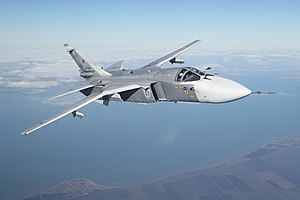Songrim SR-6
| Songrim SR-6 | |
|---|---|

| |
| SR-6N in queue for in-air refueling | |
| Role | Strike bomber |
| National origin | DPRM |
| Manufacturer | Songrim Aircraft Design Bureau |
| Introduction | 1980 |
| Primary user | Menghe |
| Produced | 1980-1998 |
| Number built | 625 |
| Developed from | Orlov Or-24 |
The Songrim SR-6 (Formal designation: 송림 6호 공격기 / 松林六號攻擊機, Songrim Ryuk-ho Gonggyŏkgi, "Songrim No.6 Attack Plane;" Short designation 송림-6 Songrim-Ryuk "Songrim-3") is a supersonic, all-weather strike bomber and interdiction aircraft built in Menghe. It originated as a license-produced version of the Letnian Orlov Or-24, but developed in parallel into its own family of variants. It remains in service with Menghean Army and Naval Aviation, though it is no longer in production, and has been steadily supplemented by the Songrim SR-8.
Design and Development
Domestic design efforts
During the late 1960s and early 1970s, the Menghean People's Army relied primarily on the Songrim SR-3 for its close air support missions. Though rugged and reliable, the SR-3 had a modest payload and a relatively limited range. It also lacked ground-search and terrain-following radar, limiting it to daytime attacks in clear weather.
Responding to these constraints, in 1976 the Menghean Ministry of Defense issued a requirement for a new strike bomber with an 8,000-kilogram payload and a 1,000-kilometer strike range. The Yŏng'an design bureau drew up a proposal with fixed swept wings and wing-root engines, in some respects a scaled-down Y-4, but it was rejected before work on a prototype could begin. Songrim also expressed interest in the competition, but its design team was working full-time to correct problems with the SR-7 interceptor, and anticipated lengthy delays for a fully domestic design.
License production
Eventually, the Ministry of Defense opted to pursue a production contract with Letnia for the Orlov Or-24, which met all of the project's requirements and could be ordered into production more quickly. Sim Jin-hwan had favored a fully domestic design, in line with the DS-5 and SR-7, but eventually he gave in to the Orlov option as it was the most practical. Eight Or-24 baseline kits were shipped to Menghe in 1978 for assembly, and in 1980 full-rate production began at a new Songrim facility in Sunchang.
Improvements
This initial SR-6G variant was based on the baseline Or-24, with the three-pronged nose probe, fin-base braking parachute, and early-model targeting scope. In the same year it entered service, the DPRM began production of the DS-5D and SR-3D, both of which used the Kayra-23 laser targeting system to guide anti-tank missiles and guided bombs. The SR-6G, which lacked this system, could not use the YGJ-40 anti-tank missile, only the anti-radiation YJG-42 and unguided bombs.
In response, Songrim developed the SR-6N, an improved variant with greater support for guided munitions. This variant added the Kayra-23 laser and electro-optical pod in a distinct centerline gondola under the fuselage. To make room for this system, the designers removed the 23mm rotary cannon, which performed poorly against armored targets in test runs. The layout of the braking parachute container was modified, and a ram air intake at the base of the tail fin was added to cool the generator system. The original three-pronged nose probe was retained, as was the original radar set, and no in-flight refueling probe was added; these features distinguish the SR-6N from the Or-24M, a contemporaneous modernization in Letnia which was not exported to Menghe.
Operational history
Polvokian Civil War
Ummayan Civil War
Innominadan Crisis
Menghean inventory
With the introduction of the Songrim SR-8, which has a higher payload and combat radius in addition to its air-to-air capability, most surviving SR-6s have been steadily disbanded in favor of advanced multirole units.
Ministry of National Defense records indicate that 26 SR-6 airframes were lost in peacetime accidents since 1987, and 17 were lost during combat operations.
Menghean Army Aviation still operates 138 SR-6 bombers as of December 2019, divided into three electronic warfare squadrons of SR-6JJs and eight ground-attack squadrons of SR-6Ds. The Menghean Navy operates an additional 112 SR-6HGs, updated with modern surface-search radars and ECM equipment. Up to 90 SR-6Ns may remain in reserve-capable storage.
Variants
- SR-6G:
- Initial 1980 production version, based on the baseline Or-24. 76 built.
- SR-6N:
- Improved version introduced in 1983. Carries a laser targeting pod in place of the gun, and features changes to the vertical stabilizer. 275 built, accounting for close to half of all DS-6 production.
- SR-6HG:
- Dedicated naval strike version for the Menghean People's Navy. Easily recognizable for its widened nose containing a long-range sea-search radar. The inboard pylons were also strengthened, and can support the YDH-23 heavy anti-ship missile. 118 built between 1984 and 1989.
- SR-6HM:
- Proposed CATOBAR modification for carrier-based operations. One airframe was completed in 1985, but it was apparently never tested aboard the Haebang-class carriers; the lighter DS-5HMG was used instead.
- SR-6D:
- Improved variant introduced in 1992, after Menghe gained access to improved electronics. It has a thoroughly redesigned nose section with an AN/APG-67 radar for ground mapping and terrain following. 113 built.
- SR-6JJ:
- Dedicated electronic warfare variant with SIGINT equipment in the fuselage sides and a powerful jamming antenna in the nose. The Kayra-23 targeting system under the fuselage is removed to make room for additional electronics, but the plane can carry radar-homing and air-to-air missiles. 42 built between 1993 and 1998.
Operators
- Template:Country data Azbekistan: 40 SR-6Ns exported in 1994
 Republic of Innominada: 38 SR-6Ns exported in 2016
Republic of Innominada: 38 SR-6Ns exported in 2016 Menghe: 250 (2019)
Menghe: 250 (2019)- Template:Country data Ummayah: 84 SR-6Ns exported in 2006-2009